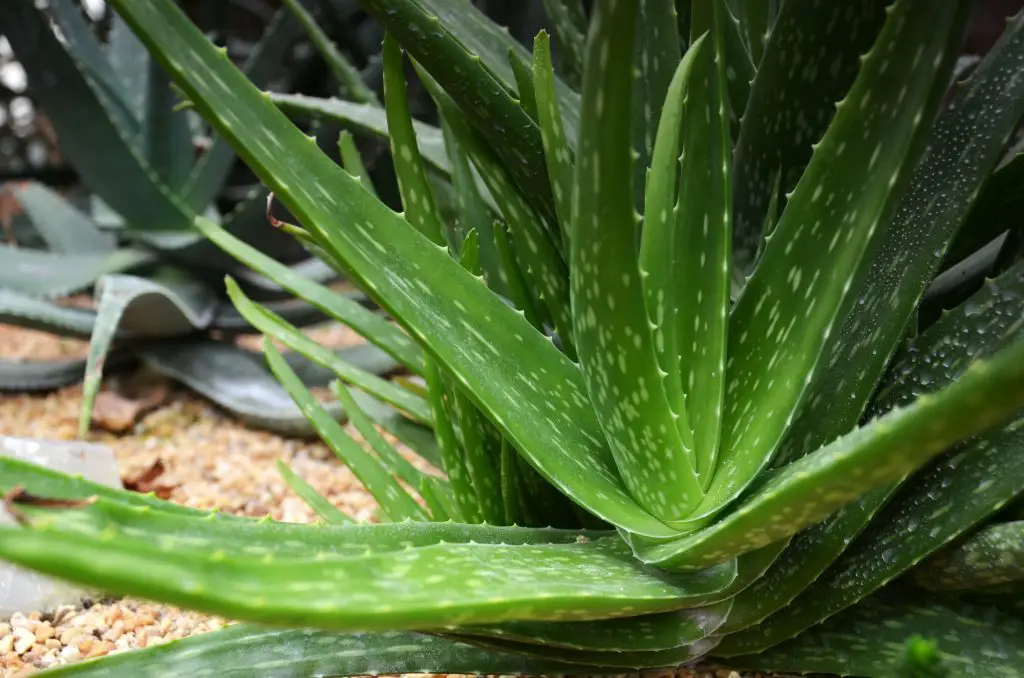Aloe vera plants are one of the best choices for a houseplant. They are incredibly durable and don’t require a lot of care, plus they have some fantastic healing properties! But you notice that your aloe vera is beginning to turn into a lighter green, so what happened?
Aloe vera plants turn light green for a number of reasons, and it is often a sign that the plant may have been exposed to unfavorable conditions. However, there are many different reasons a plant might become paler, and it is typically not a major concern. As a matter of fact, it is an easy fix as well!
The rest of this article will explain what causes an aloe vera plant to turn light green and how to fix it.
Why Is My Aloe Vera Turning Light Green?
Aloe vera plants turn light green for various reasons, and the good news is that most of these are common and are not a be-all-end-all for your plant. It is most likely that your plant is turning light green because it has been exposed to unfavorable conditions. The aloe vera may fade to a light green before fading to a pale yellow color and then turning light brown.
Overwatering/Underwatering
Aloe plants do not require a lot of water, and typically watering them once a week in the summer and once every two weeks in the winter will be sufficient. However, because they do not require a lot of water, it can be easy to overwater them. An overwatered aloe plant will often fade in color and eventually rot away.
Underwatering an aloe plant could also cause the leaves to become lighter green, which can be a sign of stress. When they do not receive enough water, aloe plants will go into survival mode, turning some of the focus away from the leaves in order to keep the plant alive.
Overpotting
While aloe plants require containers that are not too shallow in order to give the roots space to grow and not suffocate the plant, overpotting can also cause problems.
Having a pot that is much too large can cause waterlogging, as the root system won’t be able to absorb all the water in the soil. The soil will then hold the rest of the water, and this has a similar effect to overwatering a plant.
Changes in Growing Conditions
Aloe plants are generally very durable; however, abrupt changes in their growing conditions can cause them to become stressed, which can cause their leaves to turn light green.
This stress can be caused by moving a plant from indoors to outdoors, particularly if it is placed in direct sunlight, which can damage the tips of the leaves. Unexpected drought conditions can also stress out the plant as moisture becomes scarce. Lastly, abrupt seasonal changes may also cause the leaves to lighten, particularly if there is a sudden shift to cold weather.
Younger Aloe Plants
If you have a younger aloe plant, it is possible that lighter green leaves are not a sign of health problems or unfavorable conditions at all. Lighter green leaves on a younger plant are considered completely normal and can be caused by moving them to a place with natural environmental conditions that will not be found in a greenhouse or plant nursery.
New leaves that grow on the aloe plant may also be a lighter green, as they have not yet developed to have the “right” shade of green that is characteristic of aloe vera plants.
Lack of Fertilization
Aloe vera plants do not require a lot of water or fertilization and generally do very well on their own. However, a neglected aloe plant may become discolored, and the leaves may turn a lighter shade of green. If you have ruled that this change in color is not a result of over or under-watering, or sudden changes in living conditions, your plant might require some extra nutrients.

Why Does My Aloe Plant Look Pale?
Your aloe plant may look pale for a number of reasons, most likely due to environmental stressors.
Overwatering/Underwatering
As discussed previously, overwatering and underwatering can cause discoloration in aloe vera plants, leading them to turn a light green or become paler in color. This is due to the fact that overwatering can suffocate the roots, preventing them from absorbing the nutrients and oxygen they need to survive. Underwatering can cause stress, which can result in leaf discoloration.
Potting Shock
Discoloration of leaves in an aloe vera is often caused by stress, which can result in paler or yellowing leaves. If you have recently relocated your plant by repotting it or moving in outside and have noticed it becoming pale, this is likely a response to potting shock.
Nutrient Deficiency
Aloe plants do not require a lot of assistance to thrive; however, like any other plant, they need enough nutrients to remain healthy. Nutrient deficiency can cause an unhealthy appearance. If your aloe vera plant is becoming pale or yellow even though you are watering it properly and it is receiving adequate sunlight, the discoloration may be due to nutrient deficiency.
Wondering why your Aloe Vera is turning yellow?
Insufficient Light
Plants conduct photosynthesis by absorbing light, which their chlorophyll assists with, and which also causes their green color. When aloe plants do not receive enough light, they may turn yellow and lose their green color, becoming paler. However, if placed in too much direct sunlight, particularly in the summer, the leaves may become yellow or pale as they are burned.
Fertilizer Burn
Aloe vera plants do not typically need extra fertilizer, but if you do choose to use some on your plant and begin to notice the leaves looking pale or yellow, it is likely from fertilizer burn. Fertilizer burn happens when too much synthetic fertilizer is applied to the plant, which can cause stress.
How To Get The Right Green Color To Aloe Leaves
In order to get the right green color to your aloe vera’s leaves, you need to correct the conditions that are causing the plant to become unhealthy. This also requires you to identify what the problem(s) is, but don’t stress; this isn’t as tedious as it sounds!
Environmental changes such as temperatures or location changes can cause discoloration, and this may be the most obvious culprit. If this isn’t it, check to make sure your plant isn’t being over or under-watered and make sure it is receiving enough sunlight. Once you know what is causing your plant to turn light green, you can learn how to fix it below!
Watering Practices
If your aloe is suffering from being overwatered or underwatered, revisit your watering practices and determine a constant watering schedule. In the summer, when it’s hotter, aloe plants need water about once a week, but in the winter or when it’s cooler, watering it once every two weeks should be sufficient.
If the soil is still moist the next time you go to water it, postpone your watering until the soil is drier. If it is particularly dry, consider watering it a bit more frequently so long as the soil continues to dry faster.
Sunlight Solutions
Your plant may not be receiving enough sun, or it may be receiving too much. Aloe vera plants require a lot of sunlight, but too much direct sunlight can be harsh and cause the plant to burn or dry out.
The optimal environment for your aloe vera is in a location where it receives partial sunlight. For example, a windowsill that receives a decent amount of light but is not in sunlight all day is a good option.
Potting and Relocation
Repotting or moving an aloe vera plant can introduce it to new conditions, which can cause stress and discoloration. When repotting, make sure to pick a pot that is not too cramped but not too large, allowing the plant to grow without experiencing extreme changes in its living environment.
When relocating a plant, particularly if you are moving it from indoors to outdoors, do so more gradually, allowing it to adjust. You can do this by keeping it in a more sheltered area, protected from rain and direct sunlight.
Fertilizer Dos and Don’ts
Aloe vera plants are very hardy and able to survive mostly on their own, and therefore they do not require a lot of fertilizer. Too much fertilizer, as said earlier, can cause fertilizer burn, which is harmful to the plant.
To keep your aloe vera healthy, giving it fertilizer every three to four months is sufficient. A general-purpose fertilizer will work well.
Overall Care
Keeping your aloe vera plant healthy and well cared for is important to prevent discoloration of leaves. One way to maintain your plant is by harvesting some of the older leaves. Harvesting these leaves allows new leaves to grow, but try to only remove the leaves that are damaged or turning pale/yellow. You should not harvest fresh leaves.
Conclusion
Aloe vera plants are very durable houseplants that do not require a lot of attention to thrive. However, if you notice your aloe vera turning light green or becoming pale, it could be a sign that it is experiencing unfavorable conditions.
Luckily, this is an easy fix, and you can get the correct green back to the leaves by identifying the cause of the discoloration and following the simple steps to fix it!








